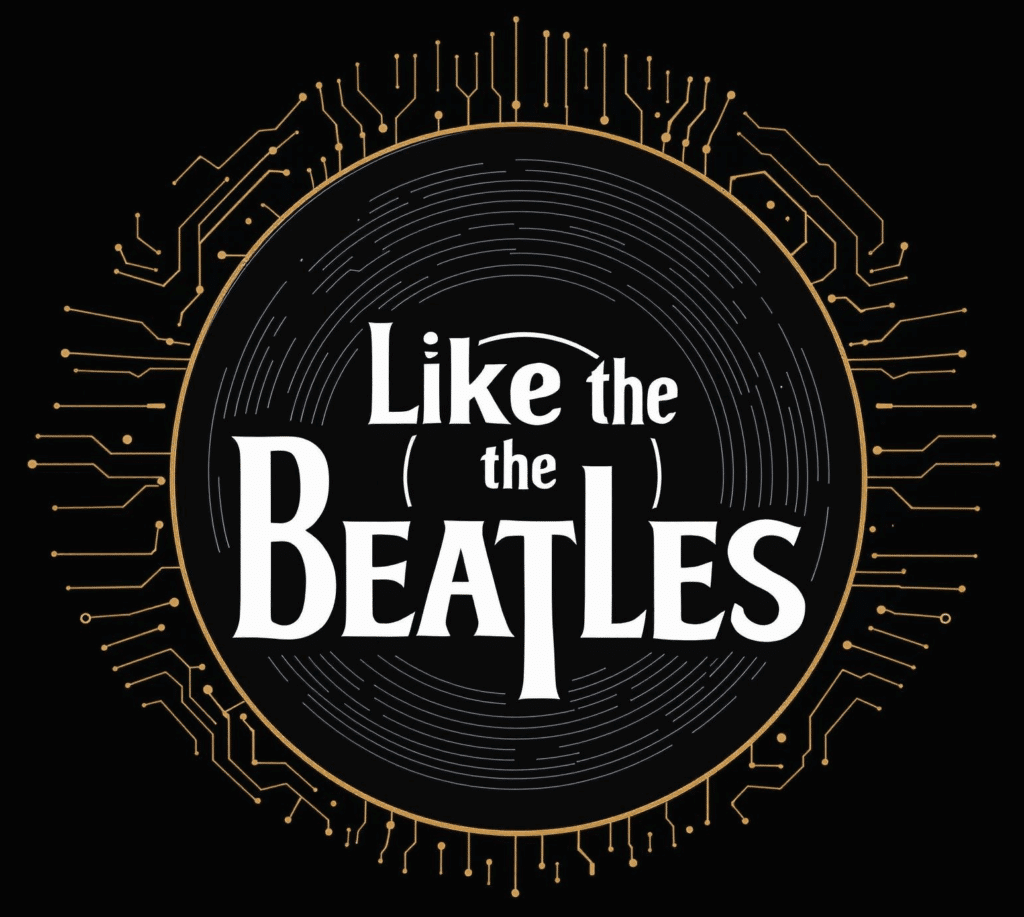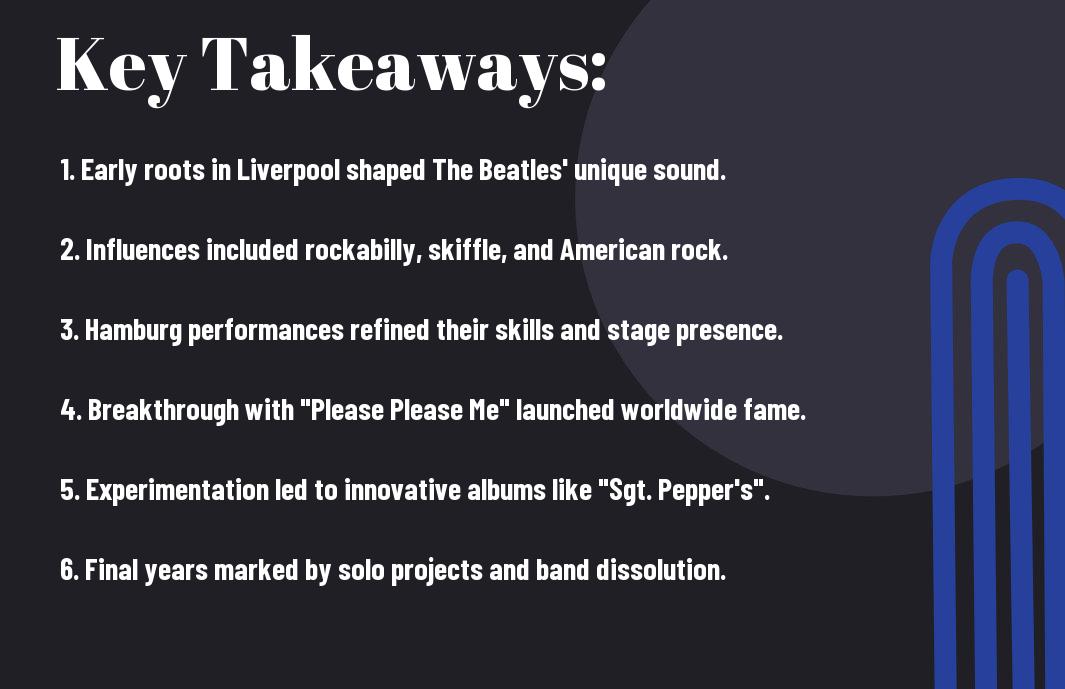Many fans and music enthusiasts find themselves captivated by the remarkable journey of The Beatles. In this blog post, I will guide you through seven key steps that chart their evolution from local Liverpool band to global superstars. You’ll discover how their innovative sound and changing styles reflect cultural shifts, and I’ll share insights into how their music revolutionized the industry. Join me as we examine into the impact of their extraordinary journey and the legacy they left behind.
The Early Years: Formation and First Singles
The journey of The Beatles began in the late 1950s with the formation of The Quarrymen, a skiffle band that featured John Lennon, Paul McCartney, and George Harrison. This period was marked by their early performances in Liverpool, where they were influenced by rock ‘n’ roll icons like Elvis Presley and Buddy Holly. As they honed their skills, their passion for music and camaraderie laid the groundwork for the legendary band that would soon take the world by storm.
The Quarrymen and Early Influences
Along this musical pathway, The Quarrymen found inspiration in various genres, notably skiffle and rock ‘n’ roll. With John’s artistic vision, Paul’s melodic gift, and George’s budding talent, they established a solid foundation for what would become an unparalleled musical journey. This diverse array of influences allowed them to cultivate a sound uniquely their own, setting the stage for their future evolution.
Breakthrough with “Love Me Do”
Years later, the release of “Love Me Do” marked a significant turning point for The Beatles, as it showcased their distinctive sound and songwriting talent. This catchy tune, which became their first single, resonated with audiences and made waves on music charts. The song’s success not only captured the attention of the public but also led to an eventual recording contract with EMI, enabling the band to pursue their dreams.
Further highlighting their ascent, “Love Me Do” was a landmark achievement not only for The Beatles but also for the music industry as it heralded the arrival of a new wave of British rock. The single’s catchy harmonica riff and infectious beat garnered widespread attention, creating a buzz that propelled the band into the limelight. This breakthrough set the stage for their rapid rise to fame, inspiring countless musicians and shaping the future of popular music as we know it.
The Beatlemania Phenomenon
You cannot discuss the Beatles without mentioning the wave of Beatlemania that swept the globe. This frenzied phenomenon captured not only the hearts of fans but reshaped the landscape of music and youth culture. As their popularity soared, the Beatles became a symbol of a generation, creating an unprecedented level of adoration that echoed through radio, television, and live performances.
Rise to Fame in the UK
Fame came knocking for the Beatles in the early 1960s as their single “Love Me Do” reached the UK charts, igniting a wildfire of interest that turned into a national obsession. Their catchy melodies, distinctive style, and charismatic personalities quickly made them icons, leading to record-breaking sell-out shows and an irresistible wave of youth enthusiasm.
International Expansion and Touring
Above all, the Beatles’ appeal swiftly transitioned beyond the UK, as they begined on extensive tours that expanded their reach across continents. Their feature on The Ed Sullivan Show in 1964 marked a turning point, introducing them to American audiences and igniting Beatlemania in the United States.
With their first tour in America, the Beatles faced both overwhelming crowds and hysteria that could only be described as legendary. Fans surged forward, desperate for a glimpse of the band, leading to dangerous situations at venues. Their music crossed borders, evolving not just the rock genre but influencing culture worldwide. From the unforgettable moment at Shea Stadium, where they played to over 55,000 fans, to their iconic films, their international success solidified their status as musical royalty. Their journey wasn’t just about music; it was a revolution in popular culture and youth identity that resonated through the ages.
Creative Expansion: The Studio Years
All of The Beatles’ creative journey transformed dramatically during their studio years, showcasing their evolving artistry and experimentation. Delving deeper into their rich timeline, you can explore A History of the Beatles that marks their innovative breakthroughs and musical milestones, ultimately shaping the landscape of modern music.
Innovative Recording Techniques
With each album, The Beatles embraced innovative recording techniques that redefined studio production. They employed groundbreaking methods like tape loops, backward recordings, and varied sound effects, making their music an intricate tapestry of sonic textures that had never been seen before.
Iconic Albums: From “Rubber Soul” to “Sgt. Pepper’s”
Below the surface of popular culture, albums such as “Rubber Soul” and “Sgt. Pepper’s Lonely Hearts Club Band” marked a pivotal shift in artistic expression. Each project was a canvas where The Beatles blended diverse genres and sophisticated songwriting, influencing countless artists that followed.
Even with their transition from pop sensations to avant-garde pioneers, the albums “Rubber Soul” and “Sgt. Pepper’s” stand out as watershed moments in music history. Their experimentation with lyrical depth and musical innovation introduced concepts like the rock concept album and the fusion of different styles that shaped the sounds of the late 1960s. Tracks like “In My Life” and “Lucy in the Sky with Diamonds” not only highlighted poetic storytelling but also pushed the boundaries of what popular music could be, inviting you to embrace a whole new world of artistic possibility.
The Cultural Impact of The Beatles
Many fans and critics alike acknowledge that The Beatles were not just a band; they were a cultural phenomenon that reshaped music, art, and society. Their innovative sound and approach to music pushed boundaries, influencing generations of artists and shaping pop culture. From their whimsical lyrics to their groundbreaking studio techniques, The Beatles left an indelible mark that still resonates in today’s music and creative expressions.
Influence on Music and Fashion
Between their arrival on the scene in the early 1960s and their eventual breakup, The Beatles revolutionized music and fashion. They popularized new styles and genres, from rock and pop to avant-garde experimentation. Their ever-evolving wardrobe choices—from matching suits to psychedelic attire—set trends and reflected the changing social landscape, inspiring countless fans to embrace individuality.
The Beatles and the Counterculture Movement
To many, The Beatles were the soundtrack of the counterculture movement, embodying a spirit of rebellion and innovation during a time of social upheaval. Their music resonated with the ideals of peace, love, and freedom, encouraging young people to question authority and challenge societal norms. Through an array of songs—like “All You Need Is Love”—they became powerful symbols of the anti-establishment sentiment, connecting deeply with the movements surrounding civil rights, anti-war, and environmentalism.
Another aspect to consider is how The Beatles used their platform to advocate for social change. Their public statements and participation in events like the Anti-Vietnam War rallies signified a cultural shift, where artists began to speak out on political issues. They successfully blended art and activism, encouraging listeners to both enjoy their music and engage with the pressing issues of the time. This remarkable impact on society ensures their legacy endures as a defining element of the 1960s cultural revolution.
Challenges and Changes: The Band’s Evolution
Not every moment of The Beatles’ journey was smooth sailing. As their fame skyrocketed, they faced numerous challenges, from intense media scrutiny to personal conflicts. These pressures ultimately led to significant shifts in their dynamics and musical pursuits, reshaping the iconic band that influenced generations.
Personal Struggles and Conflicts
Among the various challenges faced by The Beatles, personal struggles and conflicts among band members significantly impacted their evolution. Tensions often arose from creative differences, lifestyle choices, and the pressures of fame, which ultimately tested the bonds that once united them as a cohesive group.
The Shift to Solo Projects
Around the late 1960s, The Beatles began to explore their individual artistic visions, leading to a shift toward solo projects. This transition marked a pivotal moment, as each member sought to express their unique creativity outside the band’s framework, ultimately altering the landscape of popular music.
Further deepening their artistic identities, solo projects allowed each member to explore varying genres and themes, from John Lennon’s raw, introspective works to Paul McCartney’s melodic and experimental endeavors. While this shift presented challenges, it also paved the way for each artist to embrace their individuality, leading to a rich legacy that resonates even today. The creative freedom found in these solo pursuits underscored their evolving relationship with music and each other, showcasing their profound impact on the music industry.
The Legacy of The Beatles
Unlike any other band in history, The Beatles’ legacy transcends their music, influencing countless artists and genres while becoming cultural symbols of the 1960s. Their innovative approach to songwriting and recording laid the groundwork for modern music, and their ability to address social issues in their lyrics helped shape public conversations. Today, their timeless tunes continue to resonate, ensuring that their impact will last for generations.
Lasting Impact on Music
After The Beatles disbanded, their influence on music remained profound. They experimented with different musical styles and pushed the boundaries of what could be achieved in the studio. Their contributions paved the way for future artists, inspiring rock, pop, and even electronic music. The band’s groundbreaking use of harmonies, production techniques, and unique songwriting set new standards that are still evident in today’s music.
Continued Relevance in Popular Culture
Against all odds, The Beatles continue to thrive in popular culture, appearing in movies, commercials, and countless tributes. Their songs are timeless anthems that resonate with new generations, introducing their profound messages to audiences unfamiliar with their original context. Iconic tracks like “Hey Jude” and “Let It Be” remain widely covered, allowing each generation to find its unique connection to the music. They have become cultural touchstones, sparking discussions about love, peace, and social change, ensuring their place in the hearts and minds of many.
With every airing of their classic hits, The Beatles remain a force in music and culture. I find it fascinating that their influence stretches beyond the confines of music alone, affecting fashion, film, and even social movements. Their image and message of unity and creativity continue to inspire artistic endeavors today. As you explore their world, you’ll discover countless modern artists, from pop icons to alternative bands, who openly credit The Beatles for their inspiration. Truly, it is their ability to consistently link with themes of love, rebellion, and change that ensures their eternal relevance.
Conclusion
Drawing together the threads of The Beatles’ evolution allows you to appreciate not just their music, but their profound impact on culture. I’ve explored seven significant steps that mark their journey from local Liverpool performances to global superstardom. As you reflect on their transformation, I hope you recognize how each phase contributed to their legacy, inspiring countless artists and fans alike. Your understanding of their story enriches your experience of their timeless music.












